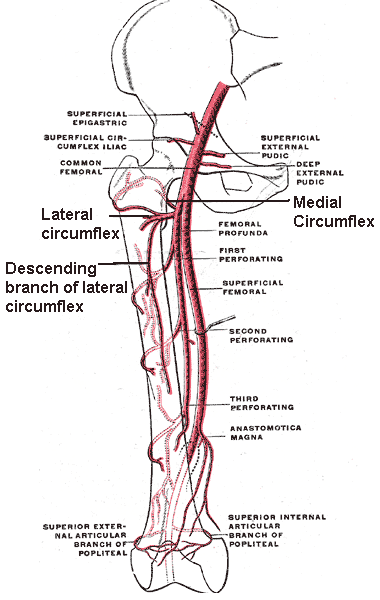[1]
Łabętowicz P, Olewnik Ł, Podgórski M, Majos M, Stefańczyk L, Topol M, Polguj M. A morphological study of the medial and lateral femoral circumflex arteries: a proposed new classification. Folia morphologica. 2019:78(4):738-745. doi: 10.5603/FM.a2019.0033. Epub 2019 Mar 25
[PubMed PMID: 30906974]
[2]
Tomaszewski KA, Henry BM, Vikse J, Roy J, Pękala PA, Svensen M, Guay DL, Saganiak K, Walocha JA. The origin of the medial circumflex femoral artery: a meta-analysis and proposal of a new classification system. PeerJ. 2016:4():e1726. doi: 10.7717/peerj.1726. Epub 2016 Feb 29
[PubMed PMID: 26966661]
Level 1 (high-level) evidence
[3]
Zlotorowicz M, Czubak-Wrzosek M, Wrzosek P, Czubak J. The origin of the medial femoral circumflex artery, lateral femoral circumflex artery and obturator artery. Surgical and radiologic anatomy : SRA. 2018 May:40(5):515-520. doi: 10.1007/s00276-018-2012-6. Epub 2018 Apr 12
[PubMed PMID: 29651567]
[4]
Artero GE, Ulla M, Neligan PC, Angrigiani CH. Bilateral Anatomic Variation of Anterolateral Thigh Flap in the Same Individual. Plastic and reconstructive surgery. Global open. 2018 May:6(5):e1677. doi: 10.1097/GOX.0000000000001677. Epub 2018 May 18
[PubMed PMID: 29922539]
[5]
Valdatta L, Tuinder S, Buoro M, Thione A, Faga A, Putz R. Lateral circumflex femoral arterial system and perforators of the anterolateral thigh flap: an anatomic study. Annals of plastic surgery. 2002 Aug:49(2):145-50
[PubMed PMID: 12187341]
[6]
Goel S, Arora J, Mehta V, Sharma M, Suri RK, Rath G. Unusual disposition of lateral circumflex femoral artery: Anatomical description and clinical implications. World journal of clinical cases. 2015 Jan 16:3(1):85-8. doi: 10.12998/wjcc.v3.i1.85. Epub
[PubMed PMID: 25610855]
Level 3 (low-level) evidence
[7]
Dewar DC, Lazaro LE, Klinger CE, Sculco PK, Dyke JP, Ni AY, Helfet DL, Lorich DG. The relative contribution of the medial and lateral femoral circumflex arteries to the vascularity of the head and neck of the femur: a quantitative MRI-based assessment. The bone & joint journal. 2016 Dec:98-B(12):1582-1588
[PubMed PMID: 27909118]
[8]
Ogden JA. Changing patterns of proximal femoral vascularity. The Journal of bone and joint surgery. American volume. 1974 Jul:56(5):941-50
[PubMed PMID: 4847241]
[9]
Tomaszewski KA, Vikse J, Henry BM, Roy J, Pękala PA, Svensen M, Guay D, Saganiak K, Walocha JA. The variable origin of the lateral circumflex femoral artery: a meta-analysis and proposal for a new classification system. Folia morphologica. 2017:76(2):157-167. doi: 10.5603/FM.a2016.0056. Epub 2016 Oct 7
[PubMed PMID: 27714726]
Level 1 (high-level) evidence
[10]
Prakash, Kumari J, Kumar Bhardwaj A, Jose BA, Kumar Yadav S, Singh G. Variations in the origins of the profunda femoris, medial and lateral femoral circumflex arteries: a cadaver study in the Indian population. Romanian journal of morphology and embryology = Revue roumaine de morphologie et embryologie. 2010:51(1):167-70
[PubMed PMID: 20191139]
[11]
Nakajima Y, Fujii T, Mukai K, Ishida A, Kato M, Takahashi M, Tsuda M, Hashiba N, Mori N, Yamanaka A, Ozaki N, Nakatani T. Anatomically safe sites for intramuscular injections: a cross-sectional study on young adults and cadavers with a focus on the thigh. Human vaccines & immunotherapeutics. 2020:16(1):189-196. doi: 10.1080/21645515.2019.1646576. Epub 2019 Aug 23
[PubMed PMID: 31403356]
Level 2 (mid-level) evidence
[12]
Zhang M, Pessina MA, Higgs JB, Kissin EY. A Vascular Obstacle in Ultrasound-Guided Hip Joint Injection. Journal of medical ultrasound. 2018 Apr-Jun:26(2):77-80. doi: 10.4103/JMU.JMU_8_17. Epub 2018 Jun 12
[PubMed PMID: 30065523]
[13]
Strickland BA, Bakhsheshian J, Rennert RC, Fredrickson VL, Lam J, Amar A, Mack W, Carey J, Russin JJ. Descending Branch of the Lateral Circumflex Femoral Artery Graft for Posterior Inferior Cerebellar Artery Revascularization. Operative neurosurgery (Hagerstown, Md.). 2018 Sep 1:15(3):285-291. doi: 10.1093/ons/opx241. Epub
[PubMed PMID: 30125010]
[14]
Arbeloa-Gutierrez L, Arenas-Miquelez A, Muñoa L, Gordillo A, Eslava E, Insausti I, Martínez de Morentin J. Lateral circumflex femoral artery false aneurysm as a complication of intertrochanteric hip fracture with displaced lesser trochanter. Journal of surgical case reports. 2019 Jun:2019(6):rjz184. doi: 10.1093/jscr/rjz184. Epub 2019 Jun 18
[PubMed PMID: 31249660]
Level 3 (low-level) evidence

